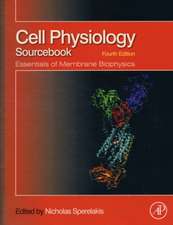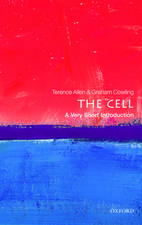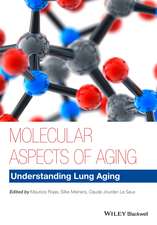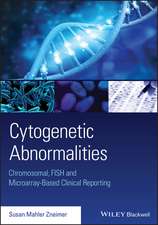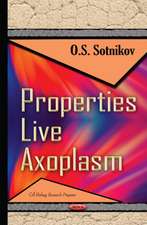Store-Operated Ca²⁺ Entry (SOCE) Pathways: Emerging Signaling Concepts in Human (Patho)physiology: Advances in Experimental Medicine and Biology, cartea 993
Editat de Klaus Groschner, Wolfgang F. Graier, Christoph Romaninen Limba Engleză Paperback – 10 aug 2018
| Toate formatele și edițiile | Preț | Express |
|---|---|---|
| Paperback (1) | 1316.97 lei 38-44 zile | |
| Springer International Publishing – 10 aug 2018 | 1316.97 lei 38-44 zile | |
| Hardback (1) | 1567.84 lei 6-8 săpt. | |
| Springer International Publishing – 20 sep 2017 | 1567.84 lei 6-8 săpt. |
Din seria Advances in Experimental Medicine and Biology
- 9%
 Preț: 719.60 lei
Preț: 719.60 lei - 20%
 Preț: 691.93 lei
Preț: 691.93 lei - 5%
 Preț: 717.00 lei
Preț: 717.00 lei - 5%
 Preț: 716.28 lei
Preț: 716.28 lei - 5%
 Preț: 717.20 lei
Preț: 717.20 lei - 15%
 Preț: 640.24 lei
Preț: 640.24 lei - 5%
 Preț: 1113.83 lei
Preț: 1113.83 lei - 5%
 Preț: 715.71 lei
Preț: 715.71 lei - 5%
 Preț: 820.43 lei
Preț: 820.43 lei - 15%
 Preț: 641.38 lei
Preț: 641.38 lei - 5%
 Preț: 716.28 lei
Preț: 716.28 lei - 5%
 Preț: 523.99 lei
Preț: 523.99 lei - 5%
 Preț: 1031.00 lei
Preț: 1031.00 lei - 5%
 Preț: 717.00 lei
Preț: 717.00 lei - 5%
 Preț: 715.35 lei
Preț: 715.35 lei - 20%
 Preț: 1161.71 lei
Preț: 1161.71 lei - 5%
 Preț: 1170.51 lei
Preț: 1170.51 lei - 18%
 Preț: 1119.87 lei
Preț: 1119.87 lei - 5%
 Preț: 1288.48 lei
Preț: 1288.48 lei - 5%
 Preț: 1164.67 lei
Preț: 1164.67 lei - 5%
 Preț: 1101.73 lei
Preț: 1101.73 lei - 18%
 Preț: 1123.67 lei
Preț: 1123.67 lei - 5%
 Preț: 1435.64 lei
Preț: 1435.64 lei - 20%
 Preț: 1044.10 lei
Preț: 1044.10 lei - 18%
 Preț: 946.39 lei
Preț: 946.39 lei - 5%
 Preț: 292.57 lei
Preț: 292.57 lei - 18%
 Preț: 957.62 lei
Preț: 957.62 lei - 18%
 Preț: 1235.76 lei
Preț: 1235.76 lei - 5%
 Preț: 1231.55 lei
Preț: 1231.55 lei - 5%
 Preț: 1292.30 lei
Preț: 1292.30 lei - 5%
 Preț: 1102.10 lei
Preț: 1102.10 lei - 18%
 Preț: 1132.81 lei
Preț: 1132.81 lei - 5%
 Preț: 1165.19 lei
Preț: 1165.19 lei - 5%
 Preț: 1418.48 lei
Preț: 1418.48 lei - 5%
 Preț: 1305.63 lei
Preț: 1305.63 lei - 18%
 Preț: 1417.72 lei
Preț: 1417.72 lei - 18%
 Preț: 1412.99 lei
Preț: 1412.99 lei - 24%
 Preț: 806.16 lei
Preț: 806.16 lei - 18%
 Preț: 1243.29 lei
Preț: 1243.29 lei - 5%
 Preț: 1429.44 lei
Preț: 1429.44 lei - 5%
 Preț: 1618.70 lei
Preț: 1618.70 lei - 5%
 Preț: 1305.12 lei
Preț: 1305.12 lei - 18%
 Preț: 1124.92 lei
Preț: 1124.92 lei - 5%
 Preț: 1097.54 lei
Preț: 1097.54 lei - 15%
 Preț: 649.87 lei
Preț: 649.87 lei - 5%
 Preț: 1097.54 lei
Preț: 1097.54 lei - 18%
 Preț: 945.79 lei
Preț: 945.79 lei - 5%
 Preț: 1123.16 lei
Preț: 1123.16 lei
Preț: 1316.97 lei
Preț vechi: 1732.86 lei
-24% Nou
Puncte Express: 1975
Preț estimativ în valută:
252.00€ • 274.59$ • 212.35£
252.00€ • 274.59$ • 212.35£
Carte tipărită la comandă
Livrare economică 19-25 aprilie
Preluare comenzi: 021 569.72.76
Specificații
ISBN-13: 9783319862361
ISBN-10: 3319862367
Pagini: 645
Ilustrații: XXIX, 645 p. 84 illus., 62 illus. in color.
Dimensiuni: 155 x 235 mm
Ediția:Softcover reprint of the original 2nd ed. 2017
Editura: Springer International Publishing
Colecția Springer
Seria Advances in Experimental Medicine and Biology
Locul publicării:Cham, Switzerland
ISBN-10: 3319862367
Pagini: 645
Ilustrații: XXIX, 645 p. 84 illus., 62 illus. in color.
Dimensiuni: 155 x 235 mm
Ediția:Softcover reprint of the original 2nd ed. 2017
Editura: Springer International Publishing
Colecția Springer
Seria Advances in Experimental Medicine and Biology
Locul publicării:Cham, Switzerland
Cuprins
Part 1. SOCE - Fundamental Mechanistic Concepts.- 1. Introduction.- 2. STIM/Orai Structures: Isolated and in Complex.- 3. Orai, the Pore-Forming Subunit of the CRAC Channel.- 4. The Interactions between STIM and Orai.- 5. Conformational Coupling between STIM and Orai in the Activation of Store-operated Ca2+ Entry.- 6. Regulation of STIM and Orai by Thiol Modifications.- 7. Light-operated Ca2+ entry Through Engineered CRAC Channels.- 8. Ca2+ Influx Channels: The Orai-STIM1-TRPC Complexes.- 9. Contribution of TRPC1 in Store-operated Ca2+ Entry: Impact on Ca2+ Signaling and Cell Function.- 10. Auxiliary Proteins of the STIM/Orai Complex.- Part 2.SOCE - Crosstalk between Organelle and Cellular Compartments.- 11. Introduction.- 12. The Role of the ER and ER-Plasma Membrane Junctions in the Regulation of SOCE.- 13.TRPC Proteins as a Link between Plasma Membrane Ion Transport and Intracellular Ca2+ Stores.- 14. The Role of Mitochondria in the Activation/Maintenance of SOCE Store-operated Ca2+Entry and Mitochondria.- 15. The Role of Mitochondria in the Activation/Maintenance of SOCE Membrane Contact Sites as Signaling Hubs Sustaining Store-operated Ca2+ Entry.- 16.The Role of Mitochondria in the Activation/Maintenance of SOCE - The Contribution of Mitochondrial Ca2+ Uptake, Mitochondrial Motility and Location to Store-operated Ca2+ Entry.- 17.Tissue specificity - The Role of Organellar Membrane Nanojunctions in Smooth Muscle Ca2+ Signaling.- 18. Tissue specificity SOCE – Implications for Ca2+ Handling in Endothelial Cells.- 19. Tissue specificity - Store-operated Ca2+ Entry in Cardiac Myocytes.- Part 3. SOCE - Molecular and Cellular (Patho) Physiology.- 20. Introduction.- 21. Immunological Disorders - Regulation of Ca2+ Signaling in T Lymphocytes.- 22. Cardiovascular and Hemostatic Discorders Role of STIM and Orai Proteins in Vascular Disorders.- 23. Cardiovascular and Hemostatic Discorders SOCE and Ca2+ Handling in Platelet Dysfunction.- 24. Cardiovascular and Hemostatic Discorders - SOCE in Cardiovascular Cells – Emerging Targets for Therapeutic Intervention.- 25. Cardiac Remodelling and Disease - SOCE and TRPC Signaling in Cardiac Pathology.- 26. Cardiac Remodelling and Disease - Current Understanding of STIM1/Orai1-mediated Store-Operated Ca2+ Entry in Cardiac Function and Pathology.- 27. Neurological and Motor Disorders - Neuronal Store-operated Ca2+ Signaling: An Overview and its Function.- 28. Neurological and Motor Disorders - TRPC in Skeletal Muscle.- 29. Fertility - Store-operated Ca2+ Entry in Germ Cells: Role in Egg Activation.- 30. Metabolic Disorders and Cancer - Hepatocyte Store-operated Ca2+ Channels in Non-alcoholic Fatty Liver Disease.- 31. Metabolic Disorders and Cancer - Store-operated Ca2+ Entry in Cancer: Focus on IP3R-mediated Ca2+ Release from Intracellular Stores and its Role in Migration and Invasion.
Notă biografică
Prof. Klaus Groschner studied Pharmacy at the School of Pharmacy, University of Graz, Austria. He completed his PhD studies at the Department of Pharmacodynamics in Graz and received part of his postdoctoral education at the University of Miami, Florida, USA, studying electrophysiology and cell biology. In 1990 he became an Assistant Professor at the Department of Pharmacology and Toxicology and received his Habilitation in Pharmacology and Toxicology along with promotion to Associate Professor in 1993. Until 2011 he was head of a research unit for Physiology and Pharmacology of Membrane Transport at the Institute of Pharmaceutical Sciences at the University of Graz. Since 2012 he is Full Professor for Biophysics and Chairman at the Institute of Biophysics at the Medical University of Graz.
Prof. Wolfgang F. Graier studied Pharmacy at the University of Graz, Austria and received his PhD in Pharmacology at the Department of Pharmacology and Toxicology, Universityof Graz. In 1993, 1994 he was a postdoctoral research fellow, analyzing physiology and membrane biophysics at the Dalton Cardiovascular Research Center, University of Missouri, Columbia, USA. In 1994 he became an Assistant Professor at the Department of Medical Biochemistry, University of Graz. In 1995 he became Associate Professor (Habilitation) in Biochemical Pharmacology and in Physiology in 2001 at the Department of Medical Biochemistry, University of Graz. Since 2009 he is Full Professor for Molecular Biology and Chairman of the Institute of Molecular Biology and Biochemistry at the Medical University of Graz. Since 2015 he is also Head of the Nikon-Center of Excellence for Super-Resolution Microscopy: Cells & Organelles that is part of BioTechMed, the concerted research platform of the Medical University Graz, the University of Graz, and the Graz Technical University. In 2016 he co-founded a spin-off company named Next Generation Fluorescence Imaging, NGFI, (www.ngfi.eu).
Prof. Christoph Romanin studied Chemistry at the Technical University of Graz, Austria and completed his doctoral studies at the Department of Pharmacology and Toxicology, University of Graz. In 1986 he started with a post-doc position at the Institute of Biophysics of the University of Linz, Austria, where he became Professor in Biophysics (Habilitation) in 1993 and served as an Associate Professor since 1997. In 2001 he was a guest researcher at the NIA, the National Institute on Aging of the NIH in Bethesda, USA. Currently, he is vice-chairman of the institute and head of the Ion Channel Group at the Institute of Biophysics in Linz, Austria.
Prof. Wolfgang F. Graier studied Pharmacy at the University of Graz, Austria and received his PhD in Pharmacology at the Department of Pharmacology and Toxicology, Universityof Graz. In 1993, 1994 he was a postdoctoral research fellow, analyzing physiology and membrane biophysics at the Dalton Cardiovascular Research Center, University of Missouri, Columbia, USA. In 1994 he became an Assistant Professor at the Department of Medical Biochemistry, University of Graz. In 1995 he became Associate Professor (Habilitation) in Biochemical Pharmacology and in Physiology in 2001 at the Department of Medical Biochemistry, University of Graz. Since 2009 he is Full Professor for Molecular Biology and Chairman of the Institute of Molecular Biology and Biochemistry at the Medical University of Graz. Since 2015 he is also Head of the Nikon-Center of Excellence for Super-Resolution Microscopy: Cells & Organelles that is part of BioTechMed, the concerted research platform of the Medical University Graz, the University of Graz, and the Graz Technical University. In 2016 he co-founded a spin-off company named Next Generation Fluorescence Imaging, NGFI, (www.ngfi.eu).
Prof. Christoph Romanin studied Chemistry at the Technical University of Graz, Austria and completed his doctoral studies at the Department of Pharmacology and Toxicology, University of Graz. In 1986 he started with a post-doc position at the Institute of Biophysics of the University of Linz, Austria, where he became Professor in Biophysics (Habilitation) in 1993 and served as an Associate Professor since 1997. In 2001 he was a guest researcher at the NIA, the National Institute on Aging of the NIH in Bethesda, USA. Currently, he is vice-chairman of the institute and head of the Ion Channel Group at the Institute of Biophysics in Linz, Austria.
Textul de pe ultima copertă
This second edition of the book on Store-operated Ca2+ Entry Pathways has been updated with the newest discoveries that emerged in the field within the last five years. The crystal structure of the Ca2+ signaling core complex is described which adds to a new understanding of the molecular interactions involved. Each chapter has been revised and extended. The book retains its interdisciplinary approach and supplies biochemists, cell biologists and biophysicists as well as clinicians in immunology, neurology and cardiology with valuable information on Ca2+ signaling mechanisms, functions, dysfunctions and their consequences.
Caracteristici
Describes the role of SOCE pathways in health and disease Combines basic research with clinical aspects The second edition was updated with new discoveries in the field of structural biology, optogenetics and disease Introduces the most recent concepts of linkage between SOCE and mitochondrial Ca2+ signaling Gives insight into the newly identified molecular structure of the STIM-Orai machinery at the atomic resolution level

